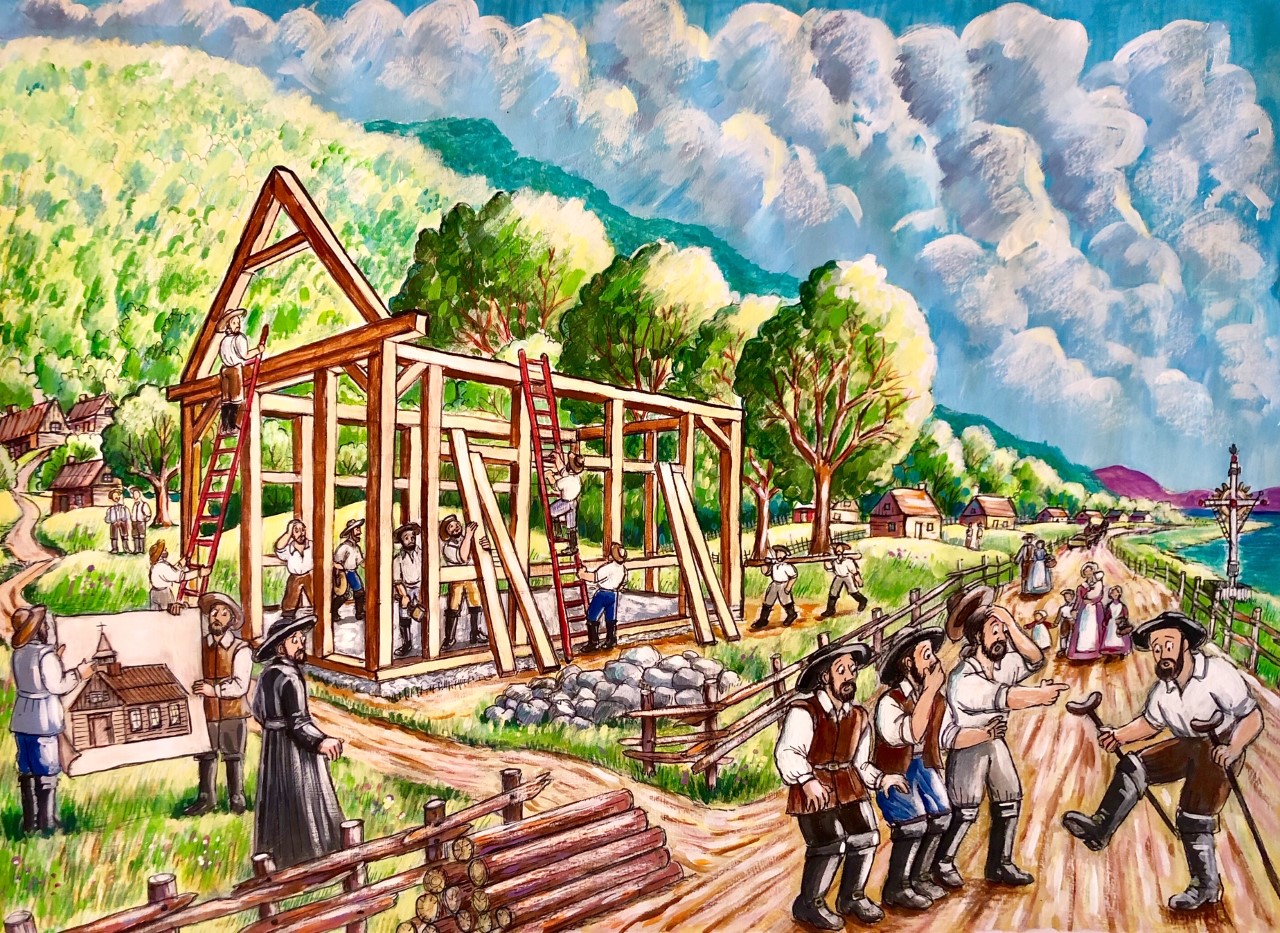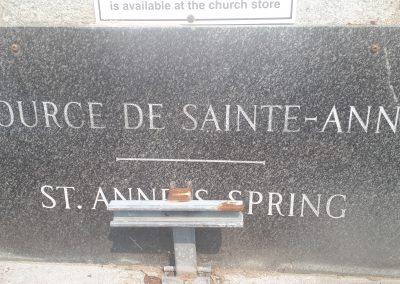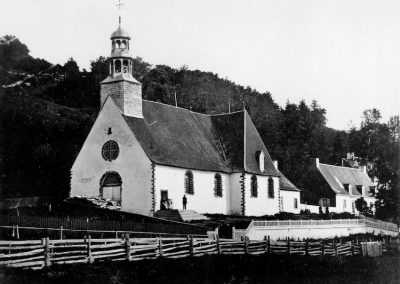Sainte-Anne-de-Beaupré’s shrine
The first church of Saint Anne in Canada:
One would be led to believe that the very first church dedicated to Saint Anne in Canada was none other than the chapel that would become the sanctuary at Beaupré, Quebec. It would seem, however, that another church preceded it and was built by Charles Daniel in 1629 in what is now Nova Scotia, on Cape Breton Island. It all began when, in 1629, Captain Charles Daniel heard that the British crown was plotting to conquer New France. He organized a fleet to go to the rescue of Samuel de Champlain. However, he was too late, as the Kirke brothers had already conquered Quebec before he arrived. Daniel decided to settle on Cape Breton Island and build Fort Sainte-Anne, located in present-day Englishtown. The small fort was soon equipped with a chapel dedicated to the Good Saint Anne. Forty people and two Jesuit fathers lived there. Other Frenchmen arrived later.
“In 1632, when Champlain returned to his colony after the treaty of Saint-Germain-en-Laye which gave Canada to France, he stopped his ships at the chapel of Cape Breton. Surrounded by his crew, his soul overflowing with thanksgiving, he thanked the great Saint for having held the key to the country so firmly during the three dark years of [Anglo-Protestant] domination” (c.f. La Bonne Sainte Anne, page 19). “The chapel of St. Anne’s in Cape Breton became a burning hearth from which the gushing lights of faith spread to the surrounding regions” (c.f. La Bonne Sainte Anne, page 21)
The church of Sainte-Anne-de-Beaupré, the second church dedicated to the patron saint of the Bretons:
A few decades later, in the 1650s, “Breton sailors sailed up the St. Lawrence. A storm arose… Fierce waves made light of the sailors’ efforts and pushed them onto the rocks. Suddenly, these sailors remember that no Breton ever invokes Saint Anne without her answering. Confident, they fall to their knees and cry out to her: Good Saint Anne, save us! They vowed to build a chapel at the place where she would surely lead their boat. Then the sea soon calmed down; the boat happily landed on the shore of Beaupré, and a few years later, a small chapel was built by the care and gratitude of the sailors” (c.f. La Bonne Sainte Anne, page 40). The land belonged to Mr. Étienne Lessard, a navigator from Beaupré, who generously offered a piece of land of two arpents in front and a league and a half deep.
The first miracle reported on the site took place during the construction of the first chapel in 1658. A handicaped man named Louis Guimond, who suffered from rheumatism, dragged himself painfully to the construction site; “full of confidence, he placed three small stones in the foundations; a sudden and new life flowed in his half-paralyzed limbs; he was healed” (c.f. La Bonne Sainte Anne, page 47). This was followed by other testimonies of healed people and the future shrine quickly gained in popularity.
The chapel was moved:
The first chapel in Beaupré, built in 1658 by Father de Queylus, Vicar General of Quebec, was built too close to the river. It was quickly damaged by the high tide. In 1661, it had to be moved to the edge of the large hill. Only the framework was kept to build what was to become the first church of Beaupré (the previous one being only a chapel, especially since it was never used for divine worship). The Governor of New France had the honor of laying the foundation stone.
The new church did not cease to gain in popularity. The miracles were more and more numerous, according to the words of Saint Marie of the Incarnation. She wrote a letter to her son on September 30, 1665: “Seven leagues from here, there is a village called Petit-Cap, where there is a church of Saint Anne in which Our Lord does great wonders in favor of this holy mother of the Blessed Virgin. The paralyzed walk there, the blind receive their sight, and the sick of any disease recover their health.

Who is Louis Guimond:
Born in the first half of the 17th century, Louis Guimond was born in the parish of Saint-Evroult de Champs (Orne, France). However the parish registers of this period having disappeared in this parish, his place of birth is not certain. He was hired on February 18, 1647 by Nicolas Juchereau, sieur de Saint-Denis for Jean Juchereau, sieur de More as a laborer for a period of 6 years for 40 livres tournois per year. The crossings there and back will be paid. He receives a pair of shoes and a woolen serge suit.
Louis Guimond could have arrived in Quebec City on August 6, 1647 aboard the ship “La Marguerite” which had left La Rochelle two months earlier. He was miraculously cured of an infirmity by coming to lay “three small stones in the foundations” of the chapel known as “es matelots” in Sainte-Anne-de-Beaupré. The news of the cure, duly attested by Abbot Thomas Morel and authenticated by Bishop François de Laval, spread and Sainte-Anne du Petit-Cap, which would become the Sainte-Anne-de-Beaupré Basilica, became a popular place of pilgrimage.
He settled in this parish with Jeanne Bitouset, a Parisian, married on February 11, 1653 in Quebec City. He lived there until the tragedy of June 18, 1661, when he was captured by the Mohawks, the most warlike of the Iroquois nation, who took him to their territory beyond Lake Champlain, in the Albany region.
Under the signature of Father Jérôme Lalement, a letter written on a birch bark by François Hertel, aged 19, captive of the Agnieronnons, and sent to his mother and then to Father Simon Le Moyne, gives us the proof of his martyrdom, at the beginning of July 1661. “He was beaten with canes and iron rods; he was given so many blows that he died under them. However, he only prayed to God, so much so that the Iroquois, enraged to see him move his lips to pray, cut off all his upper and lower lips. How horrible to see! And yet he did not let him pray; which so displeased the Iroquois that they tore his heart out of his chest, still alive, and threw it in his face. “
Saint Anne, patron saint of Quebec:
In 1876, the episcopate asked the Holy See to proclaim St. Anne patroness of the province of Quebec, we read the following note in the mandate of the archbishop of Quebec: “without prejudice, however, to the title that has been held since 1624 by St. Joseph, husband of the Blessed Virgin Mary, as patroness of all of Canada. This request was granted.
Sainte-Anne-de-Beaupré’s shrine is known for its many miracles, especially among women who have difficulty conceiving a child. The shrine is located at: 10018 Royale Avenue, Sainte-Anne-de-Beaupré, Quebec, Canada.
Sources:
-BÉLANGER, Georges, La Bonne Sainte Anne au Canada et à Beaupré
-http://www.perche-quebec.com/files/perche/individus/guimond-louis.htm







